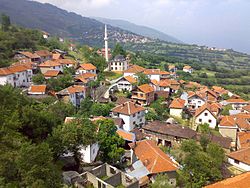Urvič, Bogovinje
Appearance
Urvič
Урвич Urviç | |
|---|---|
Village | |
 | |
| Coordinates: 41°57′N 20°54′E / 41.950°N 20.900°E | |
| Country | |
| Region | |
| Municipality | |
| Population (2021) | |
| • Total | 746 |
| Time zone | UTC+1 (CET) |
| • Summer (DST) | UTC+2 (CEST) |
| Car plates | TE |
| Website | . |
Urvič (Macedonian: Урвич, Albanian: Urviç) is a village in the municipality of Bogovinje, North Macedonia.
Demographics
Urvič, along with Jelovjane is one of two Gorani villages located in North Macedonia. The inhabitants speak the Gora dialect of Eastern South Slavic.[1][2][3][4]
As of the 2021 census, Urvič had 746 residents with the following ethnic composition:[5]
- Turks 627
- Albanians 101
- Persons for whom data are taken from administrative sources 10
- Others 8
According to the 2002 census, the village had a total of 756 inhabitants.[6] Ethnic groups in the village include:[6]
- Turks 640
- Albanians 113
- Macedonians 1
- Serbs 6
- Others 2
According to the 1942 Albanian census, Urvič was inhabited by 987 Muslim Albanians.[7]
In statistics gathered by Vasil Kanchov in 1900, the village of Urvič was inhabited by 360 Muslim Bulgarians.[8]
References
- ^ Гласник Српског географског друштва (1947). Volumes 27-30. Srpsko geografsko društvo. p. 107. "Данашњи становници Урвича и Јеловјана на супротној, полошкој страни Шар-Планине, пореклом су Горани. Много су више утицале на исељавање Горана политичке промене, настале после 1912 године. Тада се скоро четвртина становништва иселила у Турску, за коју су се преко вере и дуге управе били интимно везали. Још једна миграција јаче је захватила Горане, али не у нашој земљи, него оне који су остали у границама Арбаније."
- ^ Vidoeski, Božidar (1998). Dijalektite na makedonskiot jazik. Vol. 1. Makedonska akademija na naukite i umetnostite. pp. 309, 315. ISBN 9789989649509.
Во западна Македонија исламизирано македонско население живее во неколку географски региони на македонско-албанската пограничје:... во Полог (Јеловјане, Урвич)." "Автентичниот горански говор добро го чуваат и жителите во муслиманските оази Урвич и Јеловјане во Тетовско иако тие подолго време живеат во друго дијалектно окружување.
- ^ Rexhepi, Besnik; Mustafa, Behxhet; Hajdari, Avni; Rushidi-Rexhepi, Jehona; Quave, Cassandra L.; Pieroni, Andrea (2014). "Cross-cultural ethnobotany of the Sharr Mountains (northwestern Macedonia)". In Pieroni, Andrea; Quave, Cassandra L. (eds.). Ethnobotany and Biocultural Diversities in the Balkans. Springer. p. 70. ISBN 9781493914920.
- ^ Koleva, Krasimira (2012). "Balkanisms today: The dialect of Župa (Kosovo)". In Kahl, Thede; Metzeltin, Michael; Schaller, Helmut (eds.). Balkanismen heute – Balkanisms today – Балканизмы сегодня. LIT Verlag. p. 351. ISBN 9783643503886.
- ^ Total resident population of the Republic of North Macedonia by ethnic affiliation, by settlement, Census 2021
- ^ a b Macedonian Census (2002), Book 5 - Total population according to the Ethnic Affiliation, Mother Tongue and Religion, The State Statistical Office, Skopje, 2002, p. 111.
- ^ http://pop-stat.mashke.org/alb-historic/1942-diber-tetove-ethnicrel-loc.htm
- ^ Vasil Kanchov (1900). Macedonia: Ethnography and Statistics. Sofia. p. 264.
External links
Wikimedia Commons has media related to Urvič.

